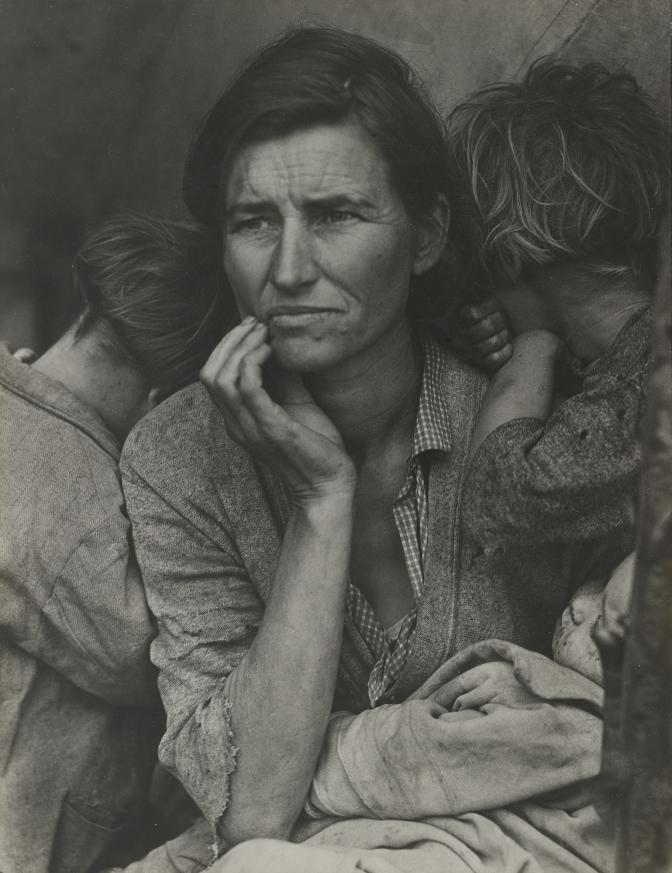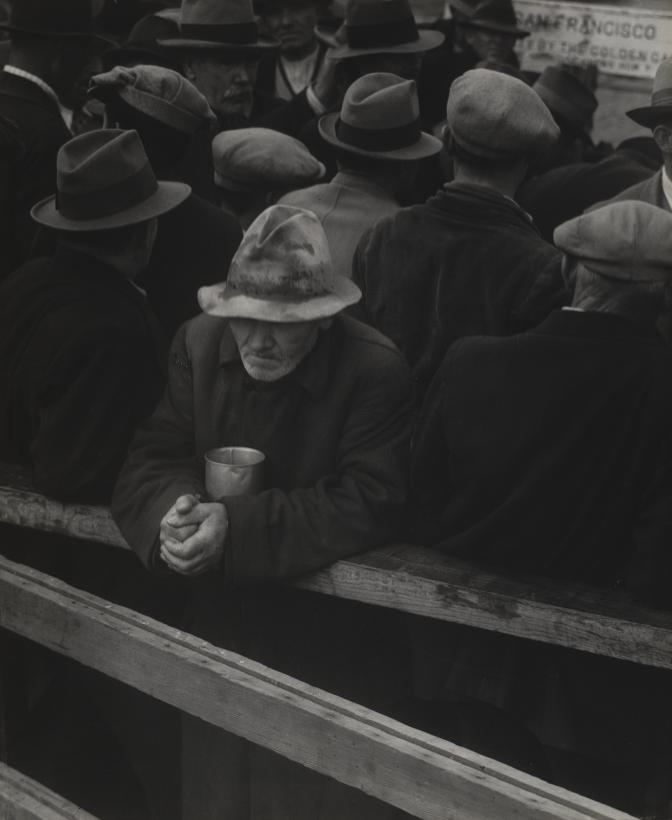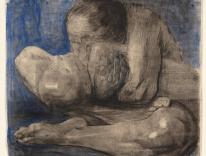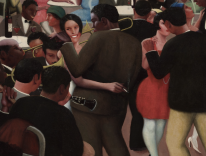To photograph him, Dorothea Lange must have had to get more than just her hands dirty. Dirt’s the first thing you notice in Jobless on the Edge of a Peafield, where an unemployed man, photographed at medium range from a low angle, crouches beside a patch of barren, rock-strewn soil. Lange’s framing is deliberate. Horizontally, we see the shoulders, elbows, and legs (but not the faces) of fellow job-seekers to his right and left; vertically, rows of dusty pea plants stretch on for miles before meeting a range of low mountains in the distance, perfectly aligned with the man’s shoulders. His tattered, sweat-stained work hat and thin, wiry build, culminating in clenched hands, bind him to the poverty of the arid California landscape—a far cry from the freedom and abundance promised by the myth of the West. But this isn’t just another image of America brought low: the composition draws our attention to the graceful (if weathered) features of the man’s face, where the taut lines begin to relax, allowing a dignified vulnerability to emerge.
Such revelatory, humanizing portraits are characteristic of Dorothea Lange’s photographic art, the subject of a new online show at the Museum of Modern Art in New York. The museum, just across the river from her native Hoboken, New Jersey, is a kind of natural home for Lange—its curators championed her work throughout her lifetime and mounted the definitive retrospective, planned with her input, just after she died in 1965. Admittedly, browsing digital reproductions at home isn’t the same as viewing the original gelatin silver prints in person. But the accompanying audio files, online essays, and video chats (featuring contributions from writers, artists, and scholars like Rebecca Solnit, Julie Ault, and curator Sarah Meister), all available free of charge, have the welcome effect of making the exhibit’s home version feel like a communal rediscovery of one of America’s greatest photographers.

Lange, of course, is best known for her iconic 1936 masterpiece Migrant Mother, a raw, haunting portrait of an impoverished woman (Florence Thompson) huddled with her children beneath a canvas tarp. It instantly became the quintessential image of the Great Depression, going “viral” in scores of newspapers, magazines, even postage stamps. Now, with the United States experiencing its highest levels of unemployment since those years, Lange’s work has taken on a new relevance. But as the show’s subtitle Words & Pictures hints, that’s not the only reason to explore it today. For if Lange was one of the country’s most innovative and influential social documentarians (and she certainly was—Robert Frank’s famous 1959 photobook The Americans was an explicit homage to her), she was also an artist with the sensitivity of a poet. Language mattered to her just as much as images; the visual illuminated the verbal, not the other way around. As attentive to the rhythms and nuances of her subjects’ speech patterns as she was to the play of light and shadow across their faces, Lange made art in order to achieve self-effacement: photography was about getting lost, letting go of her ego in order to “grab a hunk of lightning” and let reality speak for itself.
She got her first chance to do this during the early 1930s, just as the Depression was intensifying in San Francisco. After moving there from New York, Lange had opened a small portrait studio, finding favor with the city’s well-to-do and earning enough to support herself. Just outside her window, though, a different dynamic was unfolding, as unemployment led to labor demonstrations along the city’s docks and long bread lines in the streets. Lange took an instant interest, feeling compelled to leave her studio in order to, as she put it, “jostle about in groups of tormented, depressed, and angry men, with a camera.” The results were powerful: crisp shots of tense labor leaders shouting into microphones; ranks of angry picketers with signs reading “FEED US!”; a burly police officer posing proudly in a neat brass-buttoned uniform as a raucous demonstration swells behind him.

But one photo stands out from the rest, setting the ethical tone for Lange’s three-decade career in photojournalism. White Angel Bread Line presents a solitary man, dressed in a grimy hat and long gray overcoat, pausing along a rail with his hands folded and an empty tin cup before him. At his back is an indiscriminate sea of shoulders and hats, other men waiting to get something to eat. It is, in a sense, a kind of anti-portrait: we can’t see the man’s eyes, and there’s nothing marking him as an individual, nothing to distinguish him from the mass of unemployed men that share his fate. But that’s precisely the point: observing his exhaustion and capturing his poverty on film takes nothing away from his “privacy, dignity, and wholeness.” Lange hung it in her studio, receiving critical comments from wealthier clients who wondered why she’d want to display “something like that” on the wall.
Not everyone was so scandalized by Lange’s work. It soon caught the attention of Paul Taylor, the agricultural economist who would later become Lange’s husband and working partner. For years he’d been studying the socioeconomic devastation wrought by the rapid rise of industrial agriculture in the American Southwest, which exhausted the soil and forced farmers, then mostly from Mexico, to become migrant workers. After seeing Lange’s San Francisco photos, which Taylor realized could “speak” more eloquently than his academic essays ever could, he hired her as a “typist” (the fine print of his WPA funding prohibited him from hiring a photographer). The pair then set out to document and photograph the growing flows of dust-bowl migration in the Imperial Valley of Southern California.
What they found was an America most Americans knew nothing about. Prolonged drought in the Midwest (recall the opening of Steinbeck’s Grapes of Wrath) had driven scores of tenant-farmer families to pack their cars and try their luck in the pea and cotton fields of California. Lange shot them in unconventional ways, sometimes playfully, sometimes dramatically, but always respectfully, with a view to allowing their own ideas about themselves and their fortunes to emerge.
Two images in particular are worth pausing over. Six Tenant Farmers Without Farms displays a row of young men posing blithely before a ramshackle dwelling; the holes in their overalls do nothing to diminish their cockiness—one sports a brimmed cap angled jauntily over his eyes as he flexes his biceps and gazes defiantly into the camera. Child and Her Mother likewise features its subject staring into the camera, but here the effect is more somber: a skinny, forlorn child in a dirty floral dress grips a stretch of barbed wire in the foreground as her aproned mother, a little out of focus in the background, looks on from a distance. Critics have suggested that Lange’s personal anxieties about her own children are on display here. But Lange’s shots also make a broader point about the non-material effects of the Great Depression: the fact that fathers were unable to find work, and mothers were left incapable of meeting their children’s basic needs, threatened a core element of American identity. Lange is less interested, it seems, in pitying them than in getting to know them, despite their circumstances. Gazing into Lange’s lens, they find not judgment or shame, but an unexpected source of welcome, compassion, and comprehension.
In 1939, Lange and Taylor published six years’ worth of wanderings in a single photobook. American Exodus: A Record of Human Erosion sold poorly; the outbreak of war in Europe had turned the country’s attention from the Depression. But it was nevertheless revolutionary in the way it juxtaposed words (usually quotes recorded by Lange in the field) and photographs (often grouped in provocative symbolic combinations). As its title implies, the book’s argument was both scientific (erosion) and spiritual (exodus). The stripping of the soil by industrial farming had forced farmers and their families to spend years wandering through the deserts of the American Southwest. Nowhere is this tragic result more evident than in Tractored Out, which stands the tradition of American landscape painting and photography on its head by depicting a single boarded-up farmhouse languishing amid a sea of curved rows of exhausted soil. If the American West had once promised life, with flourishing fields for every family, here it’s a grim portrait of death.
Lange wasn’t religious, but as her career continued she increasingly took on the role of a biblical prophet, reminding her country (and especially its business leaders and elected officials) how far short they had fallen of their duty to promote life, liberty, and the pursuit of happiness. Her photographs of written words—especially advertisements—took an increasingly acerbic tone: On the Road to Los Angeles shows two migrant workers walking their suitcases along a dusty highway as a huge billboard, featuring a garish image of a man reclining, urges them to “relax” and “next time try the train!” And Lange’s documentation of racism, both in the Mississippi Delta and in the San Francisco Bay Area, was equally lacerating: Plantation Overseer and His Field Hands shows a heavyset white man with a straw hat and suspenders planting his thick leg on the tail bumper of his car. He looks to the left (Paul Taylor is just barely visible at the far left edge of the frame, engaging him in conversation) as his workers, five black men, look straight into Lange’s lens from behind him, as if acknowledging the man’s grotesque sense of self-importance, and the injustice of the whole situation.
Even more damning are Lange’s photos documenting the internment of Japanese Americans following the attack on Pearl Harbor. By an ironic twist, Lange’s work for the WPA during the Depression helped her secure a contract from the U.S. Army, which hired her to document the supposedly “humane” conditions at the Assembly Center in San Francisco and inside the internment camp at Manzanar. As soon as her new bosses saw the results—anonymous government hands inspecting the tags that Japanese Americans were forced to wear on their coats, frightened Japanese-American children reciting the Pledge of Allegiance, whole families in line to board buses and trains—they fired her.
If at the peak of her career Lange had found her voice as a prophet, her final years were more contemplative. She continued producing work oriented toward social and environmental justice: the show includes a few photos from her “Public Defender” project, courtroom shots originally commissioned by Life magazine that were later used to illustrate a legal handbook, Minimizing Racism in Jury Trials; and from “Death of a Valley,” which documented the reservoir construction that flooded the Berryessa Valley in Napa, California, and permanently displaced not only human residents, but an entire ecosystem. These projects aside, Lange took a deeper interest in photographing people and places closer to home. Constantly ill with ulcers in her stomach and pains in her throat (she died of throat cancer in 1965), Lange was drawn to photographing an old oak tree at her home in California. Oak Trunk and Sunlit Oak, both from 1957, stand as self-portraits: the tension between their muscular, sturdy branches, and their delicate, flowing leaves is the same combination of power, beauty, and patient growth that characterized Lange’s life and work.
We could certainly use more of Lange’s moral ferocity today. But what’s really needed is her humility, and her humanism. It’s easy to be angry: at Trump, at the governors, at Amazon and the airlines and the corporations and the Congress that bailed them out (and for that matter, at MoMA itself, whose massive expansion last fall now seems irresponsible, considering this spring’s budget cuts and layoffs). But in the long run, anger alone isn’t a winning political strategy, and it won’t solve the problem of inequality in America. The gift of Lange’s art is to show us that solidarity is rooted in selflessness, which begins not with political programs, or policy platforms, or a sense of one’s own moral and intellectual superiority over one’s political opponents, but with curiosity, and a desire to know (and even love) people different from oneself. Lange’s life of looking at others, especially those harmed by vast systems of injustice, helped her see that victims were more than just their socioeconomic scars. Now, in a time when many have lost their lives and livelihoods, she helps us reimagine a better America, one characterized by resilience, sacrifice, and hope.
Please email comments to [email protected] and join the conversation on our Facebook page.
Previous Story
A Telling Spell of Catholic ‘Leadership’
Next Story
‘Me Hearing Me’


